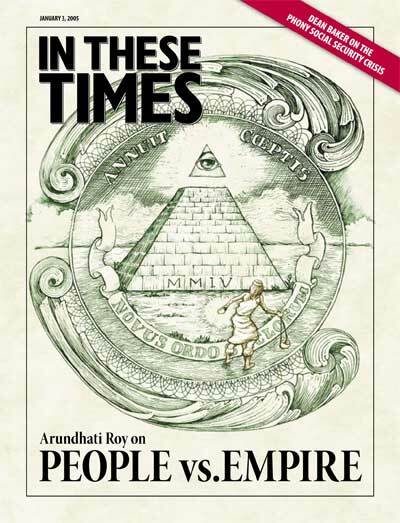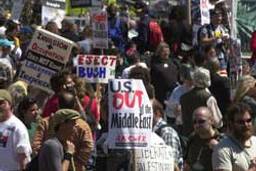
In India, the word public is now a Hindi word. It means people. In Hindi, we have sarkar and public, the government and the people. Inherent in this use is the underlying assumption that the government is quite separate from “the people.” However, as you make your way up India’s complex social ladder, the distinction between sarkar and public gets blurred. The Indian elite, like the elite anywhere in the world, finds it hard to separate itself from the state.
In the United States, on the other hand, the blurring of this distinction between sarkar and public has penetrated far deeper into society. This could be a sign of robust democracy, but unfortunately it’s a little more complicated and less pretty than that. Among other things, it has to do with the elaborate web of paranoia generated by the U.S. sarkar and spun out by the corporate media and Hollywood. Ordinary people in the United States have been manipulated into imagining they are a people under siege whose sole refuge and protector is their government. If it isn’t the Communists, it’s al Qaeda. If it isn’t Cuba, it’s Nicaragua. As a result, the most powerful nation in the world is peopled by a terrified citizenry jumping at shadows. A people bonded to the state not by social services, or public health care, or employment guarantees, but by fear.
This synthetically manufactured fear is used to gain public sanction for further acts of aggression. And so it goes, building into a spiral of self-fulfilling hysteria, now formally calibrated by the U.S government’s Amazing Technicolored Terror Alerts: fuchsia, turquoise, salmon pink.
To outside observers, this merging of sarkar and public in the United States sometimes makes it hard to separate the actions of the government from the people. Such confusion fuels anti-Americanism in the world — anti-Americanism that is seized upon and amplified by the U.S. government and its faithful media outlets. You know the routine: “Why do they hate us? They hate our freedoms,” et cetera. This enhances the U.S. people’s sense of isolation, making the embrace between sarkar and public even more intimate.
Over the last few years, the “war on terrorism” has mutated into the more generic “war on terror.” Using the threat of an external enemy to rally people behind you is a tired old horse that politicians have ridden into power for centuries. But could it be that ordinary people, fed up with that poor old horse, are looking for something different? Before Washington’s illegal invasion of Iraq, a Gallup International poll showed that in no European country was support for a unilateral war higher than 11 percent. On February 15, 2003, weeks before the invasion, more than 10 million people marched against the war on different continents, including North America. And yet the governments of many supposedly democratic countries still went to war.
We must question then: Is “democracy” still democratic? Are democratic governments accountable to the people who elected them? And, critically, is the public in democratic countries responsible for the actions of its sarkar?
If you think about it, the logic that underlies the war on terror and the logic that underlies terrorism are exactly the same. Both make ordinary citizens pay for the actions of their government. Al Qaeda made the people of the United States pay with their lives for the actions of their government in Palestine, Saudi Arabia, Iraq and Afghanistan. The U.S. government has made the people of Afghanistan pay in the thousands for the actions of the Taliban and the people of Iraq pay in the hundreds of thousands for the actions of Saddam Hussein. Whose God decides which is a “just war” and which isn’t? George Bush senior once said: “I will never apologize for the United States. I don’t care what the facts are.” When the president of the most powerful country in the world doesn’t need to care what the facts are, then we can be sure we have entered the Age of Empire.
Real choices
So what does public power mean in the Age of Empire? Does it mean anything at all? Does it actually exist? In these allegedly democratic times, conventional political thought holds that public power is exercised through the ballot. People in scores of countries around the world will go to the polls this year. Most (not all) of them will get the governments they vote for. But will they get the governments they want?
In India this year, we voted the Hindu nationalists of the BJP out of office. But even as we celebrated, we knew that on nuclear bombs, neoliberalism, privatization, censorship, big dams — on every major issue other than overt Hindu nationalism — the Congress and the BJP have no major ideological differences. We know that it is the 50-year legacy of the Congress Party that prepared the ground culturally and politically for the far right.
And what of the U.S. elections? Did U.S. voters have a real choice? The U.S. political system has been carefully crafted to ensure that no one who questions the natural goodness of the military-industrial corporate structure will be allowed through the portals of power. Given this, it’s no surprise that in this election you had two Yale University graduates, both members of Skull and Bones, the same secret society, both millionaires, both playing at soldier-solider, both talking up war, and arguing almost childishly about who would lead the war on terror more effectively. It’s not a real choice. It’s an apparent choice. Like choosing a brand of detergent. Whether you buy Ivory Snow or Tide, they’re both owned by Procter & Gamble. The fact is that electoral democracy has become a process of cynical manipulation. It offers us a very reduced political space today. To believe that this space constitutes real choice would be naive. The crisis of modern democracy is a profound one. Free elections, a free press and an independent judiciary mean little when the free market has reduced them to commodities available on sale to the highest bidder.
On the global stage, beyond the jurisdiction of sovereign governments, international instruments of trade and finance oversee a complex web of multilateral laws and agreements that have entrenched a system of appropriation that puts colonialism to shame. This system allows the unrestricted entry and exit of massive amounts of speculative capital into and out of Third World countries, which then effectively dictates their economic policy. Using the threat of capital flight as a lever, international capital insinuates itself deeper and deeper into these economies. Giant transnational corporations are taking control of their essential infrastructure and natural resources, their minerals, their water, their electricity. The World Trade Organization, the World Bank, the International Monetary Fund and other financial institutions, like the Asian Development Bank, virtually write economic policy and parliamentary legislation. With a deadly combination of arrogance and ruthlessness, they take their sledgehammers to fragile, interdependent, historically complex societies, and devastate them, all under the fluttering banner of “reform.” As a consequence of such reform, thousands of small enterprises and industries have closed; millions of workers and farmers have lost their jobs and land.
Once the free market controls the economies of the Third World they become enmeshed in an elaborate, carefully calibrated system of economic inequality. Western countries flood the markets of poorer nations with their subsidized agricultural goods and other products with which local producers cannot possibly compete. Countries that have been plundered by colonizing regimes are steeped in debt to these same powers, and have to repay them at the rate of about $382 billion a year. The rich get richer and the poor get poorer — not accidentally, but by design.
To put a vulgar point on all of this, the combined wealth of the world’s billionaires in 2004 (587 “individuals and family units”), according to Forbes magazine, is $1.9 trillion — more than the gross domestic product of the world’s 135 poorest countries combined. The good news is that there are 111 more billionaires this year than there were in 2003.
Modern democracy is safely premised on an almost religious acceptance of the nation state. But corporate globalization is not. Liquid capital is not. So even though capital needs the coercive powers of the nation state to put down revolts in the servants’ quarters, this setup ensures that no individual nation can oppose corporate globalization on its own.
Public power
Radical change cannot and will not be negotiated by governments; it can only be enforced by people. By the public. A public that can link hands across national borders. A public that disagrees with the very concept of empire. A public that has set itself against the governments and institutions that support and service Empire.
Empire has a range of calling cards. It uses different weapons to break open different markets. There’s no country on God’s earth that isn’t caught in the crosshairs of the U.S. cruise missile and the IMF checkbook. For poor people in many countries, Empire does not always appear in the form of cruise missiles and tanks, as it has in Iraq or Afghanistan or Vietnam. It appears in their lives in very local avatars — losing their jobs, being sent unpayable electricity bills, having their water supply cut, being evicted from their homes and uprooted from their land. It is a process of relentless impoverishment with which the poor are historically familiar. What Empire does is further entrench and exacerbate already existing inequalities.
Until quite recently, it was sometimes difficult for people to see themselves as victims of Empire. But now, local struggles have begun to see their role with increasing clarity. However grand it might sound, the fact is, they are confronting Empire in their own, very different ways. Differently in Iraq, in South Africa, in India, in Argentina, and differently, for that matter, on the streets of Europe and the United States.
Mass resistance movements, individual activists, journalists, artists and film makers have come together to strip Empire of its sheen. They have connected the dots, turned cash-flow charts and boardroom speeches into real stories about real people and real despair. They have shown how the neoliberal project has cost people their homes, their land, their jobs, their liberty, their dignity. they have made the intangible tangible. The once seemingly incorporeal enemy is now corporeal.
This is a huge victory. It was forged by the coming together of disparate political groups, with a variety of stratigies. But they all recognized that the target of their anger, their activism and their doggedness is the same. This was the beginning of real globalization. The globalization of dissent.
Meanwhile, the rift between rich and poor is being driven deeper and the battle to control the world’s resources intensifies. Economic colonialism through formal military aggression is staging a comeback.
Iraq today is a tragic illustration of this process. The illegal invasion. The brutal occupation in the name of liberation. The rewriting of laws to allow the shameless appropriation of the country’s wealth and resources by corporations allied to the occupation. And now the charade of a sovereign “Iraqi government.”
The Iraqi resistance is fighting on the frontlines of the battle against Empire. And therefore that battle is our battle. Before we prescribe how a pristine Iraqi resistance must conduct a secular, feminist, democratic, non-violent battle, we should shore up our end of the resistance by forcing the U.S. government and its allies to withdraw from Iraq.
Resistance across borders
The first militant confrontation in the United States between the global justice movement and the neoliberal junta took place at the WTO conference in Seattle in December 1999. To many mass movements in developing countries that had long been fighting lonely, isolated battles, Seattle was the first delightful sign that people in imperialist countries shared their anger and their vision of another kind of world. As resistance movements have begun to reach out across national borders and pose a real threat, governments have developed their own strategies for dealing with them, ranging from co-optation to repression.
Three contemporary dangers confront resistance movements: the difficult meeting point between mass movements and the mass media, the hazards of the NGO-ization of resistance, and the confrontation between resistance movements and increasingly repressive states.
The place in which the mass media meets mass movements is a complicated one. Governments have learned that a crisis-driven media cannot afford to hang about in the same place for too long. Just as a business needs cash turnover, the media need crisis turnover. Whole countries become old news, and cease to exist, and the darkness becomes deeper than before the light was briefly shone on them.
While governments hone the art of waiting out crises, resistance movements are increasingly ensnared in a vortex of crisis production that seeks to find ways of manufacturing them in easily consumable, spectator-friendly formats. For this reason, starvation deaths are more effective at publicizing impoverishment than malnourished people in the millions.
The disturbing thing nowadays is that resistance as spectacle has cut loose from its origins in genuine civil disobedience and is becoming more symbolic than real. Colorful demonstrations and weekend marches are fun and vital, but alone they are not powerful enough to stop wars. Wars will be stopped only when soldiers refuse to fight, when workers refuse to load weapons onto ships and aircraft, when people boycott the economic outposts of Empire that are strung across the globe.
If we want to reclaim the space for civil disobedience, we must liberate ourselves from the tyranny of crisis reportage and its fear of the mundane. We must use our experience, our imagination and our art to interrogate those instruments of state that ensure “normality” remains what it is: cruel, unjust, unacceptable. We must expose the policies and processes that make ordinary things — food, water, shelter and dignity — such a distant dream for ordinary people. The real preemptive strike is to understand that wars are the end result of a flawed and unjust peace.
For mass resistance movements, no amount of media coverage can make up for strength on the ground. There is no alternative, really, to old-fashioned, back-breaking political mobilization.
NGO-ization
A second hazard facing mass movements is the NGO-ization of resistance. Some nongovernmental organizations (NGOs) of course do valuable work, but it’s important to consider the NGO phenomenon in a broader political context.
Most large, well-funded NGOs are financed and patronized by aid and development agencies, which are in turn funded by Western governments, the World Bank, the United Nations and some multinational corporations. Though they may not be the very same agencies, they are certainly part of the same loose political formation that oversees the neoliberal project and demands the slash in government spending in the first place.
Why should these agencies fund NGOs? Could it be just old-fashioned missionary zeal? NGOs give the impression that they are filling the vacuum created by a retreating state. And they are, but in a materially inconsequential way. Their real contribution is that they defuse political anger and dole out as aid or benevolence what people ought to have by right. They alter the public psyche, they turn people into dependent victims and they blunt the edges of political resistance. NGOs form a sort of buffer between the sarkar and public. Between Empire and its subjects. They have become the arbitrators, the interpreters, the facilitators of the discourse — the secular missionaries of the modern world.
Eventually — on a smaller scale, but more insidiously — the capital available to NGOs plays the same role in alternative politics as the speculative capital that flows in and out of the economies of poor countries. It begins to dictate the agenda, turning confrontation into negotiation and depoliticizing resistance.
The cost of violence
This brings us to a third danger: the deadly nature of the actual confrontation between resistance movements and increasingly repressive states. Between public power and the agents of Empire.
Whenever civil resistance has shown the slightest signs of evolving from symbolic action into anything remotely threatening, the crackdown is merciless. We’ve seen what happened to the demonstrators in Seattle, in Miami, in Gothenburg, in Genoa.
In the United States, you have the USA PATRIOT Act, which has become a blueprint for antiterrorism laws passed by governments around the world. Freedoms are being curbed in the name of protecting freedom. And once we surrender our freedoms, to win them back will take a revolution.
One does not endorse the violence of militant groups. Neither morally nor strategically. But to condemn it without first denouncing the much greater violence perpetrated by the state would be to deny the people of these regions not just their basic human rights, but even the right to a fair hearing. People who have lived in situations of conflict know that militancy and armed struggle provokes a massive escalation of violence from the state. But living as they do, in situations of unbearable injustice, can they remain silent forever?
No discussion taking place in the world today is more crucial than the debate about strategies of resistance. And the choice of strategy is not entirely in the hands of the public. It is also in the hands of sarkar.
In this restive, despairing time, if governments do not do all they can to honor nonviolent resistance, then by default they privilege those who turn to violence. No government’s condemnation of terrorism is credible if it cannot show itself to be open to change by nonviolent dissent. Instead, today, nonviolent resistance movements are being crushed, bought off or simply ignored.
Meanwhile, governments and the corporate media (and let’s not forget the film industry) lavish their time, attention, funds, technology and research on war and terrorism. Violence has been deified. The message this sends is disturbing and dangerous: If you seek to air a public grievance, violence is more effective than nonviolence.
The U.S. soldiers fighting in Iraq — mostly volunteers in a poverty draft from small towns and poor urban neighborhoods — are victims, just as much as the Iraqis, of the same horrendous process that asks them to die for a victory that will never be theirs.
The mandarins of the corporate world, the CEOs, the bankers, the politicians, the judges and generals look down on us from on high and shake their heads sternly. “There’s no alternative,” they say, and let slip the dogs of war.
Then, from the ruins of Afghanistan, from the rubble of Iraq and Chechnya, from the streets of occupied Palestine and the mountains of Kashmir, from the hills and plains of Colombia, and the forests of Andhra Pradesh and Assam, comes the chilling reply: “There’s no alternative but terrorism.” Terrorism. Armed struggle. Insurgency. Call it what you want.
Terrorism is vicious, ugly and dehumanizing for its perpetrators as well as its victims. But so is war. You could say that terrorism is the privatization of war. Terrorists are the free marketers of war. They are people who don’t believe that the state has a monopoly on the legitimate use of violence.
Of course, there is an alternative to terrorism. It’s called justice. It’s time to recognize that no amount of nuclear weapons, or full-spectrum dominance, or “daisy cutters” or spurious governing councils and loya girgas can buy peace at the cost of justice.
The urge for hegemony and preponderance by some will be matched with greater intensity by the longing for dignity and justice by others. Exactly what form that battle takes, whether it’s beautiful or bloodthirsty, depends on us.









